Bradford, West Yorkshire
Up to 1834
Bradford's first workhouse was built in 1738 at Barkers End at the north-east of Bradford, at the south side of what is now Barkerend Road. A parliamentary report of 1777 recorded local workhouses in operation at Bradford (for up to 70 inmates), Allerton (30), Calverley with Farsley (40), Clayton (20), Heaton (8), Horton (40), Idle (60), Manningham (36), North Bierley and Bowling (70), and Thornton (30).
The Barkers End workhouse was rebuilt in 1790, as shown on the 1848 map below. It comprised an L-shaped building fronting onto the road, with men accommodated (by 1848) at the west and women at the east.
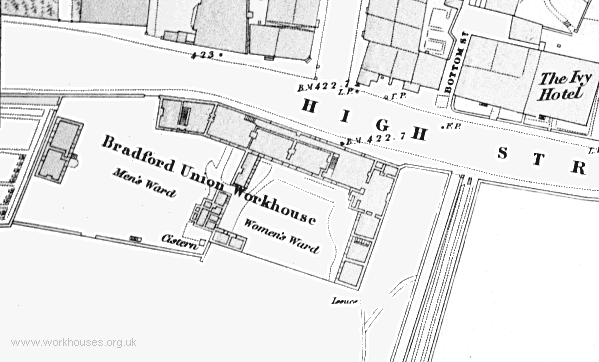
Bradford Barkers End workhouse site, 1848.
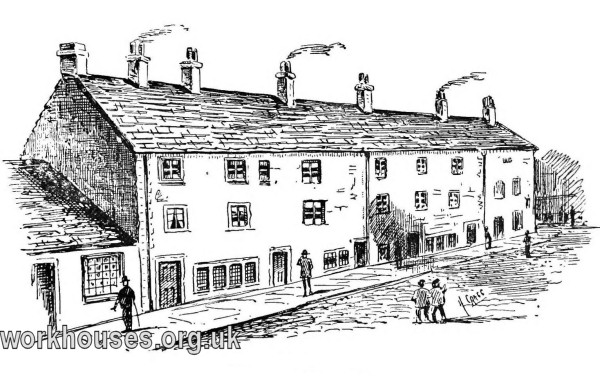
Bradford Barkerend Road workhouse from the north-east.
© Peter Higginbotham.
Eden, in his 1797 survey of the poor in England, reported of Bradford that:
The daily diet in the Barkerend workhouse in 1795 was as follows:
| Breakfast & Supper | Dinner | |
|---|---|---|
| Sunday | Porridge, milk, bread | New milk and bread, or beer, porridge and bread |
| Monday | " | Yeast dumplings or boiled puddings with vinegar sauce and beer |
| Tuesday | " | Meat broth, vegetables, beer |
| Wednesday | " | Broth, fat dumplings, beer |
| Thursday | " | Meat broth, vegetables, beer |
| Friday | " | Broth, dumplings, beer |
| Saturday | " | Meat broth, vegetables, beer |
Pudsey's provision for housing the poor dates back to at least 1639 when the churchwardens and overseers were ordered to provide "howseroome and harbour" for Stephen Braithwaite and his wife (Strong, 1982). In 1663, the township officials were required to build "a Cottage house — upon ye Waste" to accommodate Isaac Gaunt, his wife, and three small children. The township's first workhouse had been established by 1741 when Lowton innkeeper Joseph Fenton bequeathed "my uppermost cottage and dwelling house called the workhouse where the poor of Pudsey are now maintained." In 1761, conditions in this establishment were said to be "lamentable and deplorable" and at least two children of widower Paul Hudson, a Moravian, died while residing there. Following complaints by the local Moravian community, it was decided to erect a new workhouse on common land at Littlemoor, at the north side of what is now Valley Road. The inmates were engaged in cloth making and a hoist was fitted above one of the first-floor windows (see illustration below) which was used as a "taking-in" door. Supplies for the workhouse were mostly obtained from the Moravian shop at Fulneck. The shop's records include the sale of sewing materials, harding (a coarse linen used to make men's shirts and women's shifts), and wolsey (a softer fabric with a flax warp and wool weft, used for petticoats and shawls). Provisions supplied to the workhouse included hops (for brewing), clay pipes, tobacco (shag and pigtail for the men, and ladies' twist for the women), and 20 lbs of treacle per week. Other goods included lettuce seed, bedcord (for stretching across wooden bed frames), and a "bakestone" (on which to bake oatcakes). More luxurious items such as tea, sugar, and dried fruit were occasionally supplied on a separate account for the workhouse "Dame". At the rear of the workhouse was prison where miscreants were locked up until the constables could escort them to the New Inn at Bradford to be dealt with by a magistrate. At a meeting of Pudsey's "Town's Committee" on 1st February 1802, it was resolved to "discontinue the poorhouse, the occupants to be disposed of as soon as possible," and at the next meeting, two weeks later, an agreement was made with John Cooper of Littlemoor, "to board the paupers residing in the poorhouse for one year, to commence on the first day of March, 1802, and likewise to find fire for them at the rate of three shillings per week per head, to have their earnings for his own benefit — the poor to have two meat dinners per week, and likewise to be under the inspection of the Committee to see they be well kept." (Rayner, 1887). In 1830, Martin George Crowther was the workhouse Master. Little Moor Council School was built on the old workhouse site in 1891, now replaced by housing.
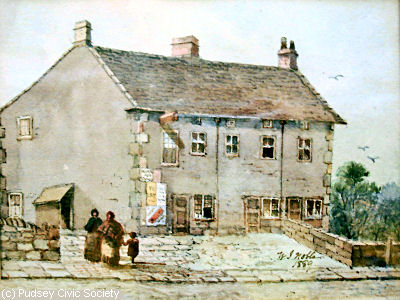
Pudsey former parish workhouse, 1889.
© Pudsey Civic Society.
The workhouse for Calverley-cum-Farsley was built in 1756 on Calverley's Back Lane, now Blackett Street, at the expense of Sir Walter Blackett (formerly Sir Walter Calverley — he changed his surname as a condition of a inheritance from his uncle). The relatively generous treatment of the inmates made it an expensive place to run — bills in 1772-3 included ones from suppliers of cloth, milk, butter, malt, groceries, veal, beef and mutton, items which would not have been available to those on out-relief. In 1778, the Overseers resorted to offering 8d. a week to Hannah Sowden for agreeing to leave the workhouse. In 1807, the twenty inmates comprised six children, nine women (two bastard-bearers, one wife and the rest widows), two were old men and three were just referred to by their surname and noted as 'old'. (King, 1997) The building no longer exists but a plaque from the original building has been preserved at the site. It reads "Sir Walter Blackett at his own Expence built this Workhouse in the year 1756."
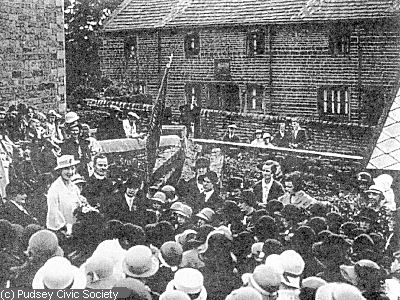
Calverley former parish workhouse (at rear), 1934.
© Pudsey Civic Society.

Calverley workhouse plaque, 2009.
© Peter Higginbotham.
Idle's workhouse was at the south side of what is now Windhill Old Road.
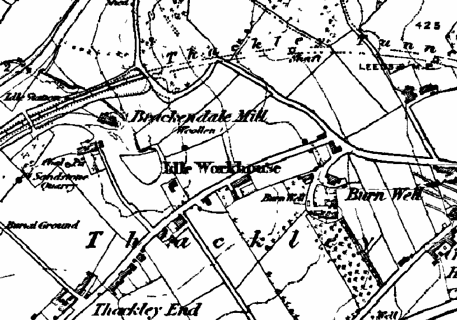
Idle workhouse site, 1852.
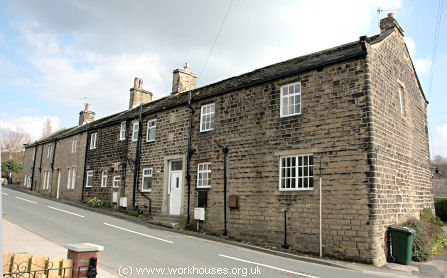
The former Idle workhouse, 2006.
© Peter Higginbotham.
There was a workhouse in Clayton in two cottages on Ramsden Place, off Town End Road. In 1841, the location was referred to as Workhouse Fold.
In 1772, Manningham and Heaton agreed to run a joint workhouse.
In 1790, the chapelry of Wibsey converted Odsal Farm into a workhouse. The buildings were later used as three cottages.
According to Baines' Directory of 1830, North Bierley had a workhouse at Hodgson Moor with John Wilkinson as its Governor.
Allerton had a workhouse near Allerton Hall in a property known as Dean House.
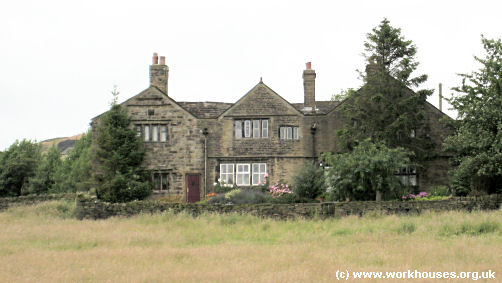
Allerton former parish workhouse, 2009.
© Peter Higginbotham.
The Horton parish workhouse was located in what became Horton Park. Its first recorded master was Tom Carter, a cow doctor and dentist, who was succeeded by Jeremy Haley, Dan Booth, and William Marshall. The building was demolished in 1822 following the transfer of the workhouse to premises at Horton Green. The old site was bought by a Leeds wool merchant named Noble who erected a residence known as Well Close House.
In 1812, when there was a national shortage of coins, Bradford was one a several urban workhouses to issue poor relief in the form of specially minted workhouse tokens. These were useable at local shops and could be redeemed by shop-keepers at the workhouse or union offices.
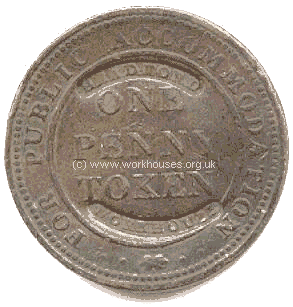
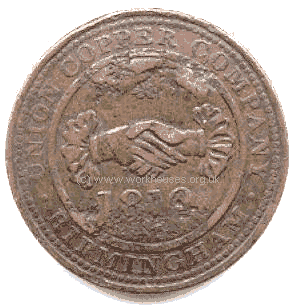
Bradford workhouse token.
© Peter Higginbotham.
After 1834
Bradford Poor Law Union was formed on 10th February 1837. Its operation was overseen by an elected Board of Guardians, 32 in number, representing its 20 constituent parishes as listed below (figures in brackets indicate numbers of Guardians if more than one):
West Riding of Yorkshire: Allerton, Bolton, Bowling (2), Bradford (6), Calverley with Farsley, Clayton, Cleckheaton, Drighlington, Heaton, Horton (3), Hunsworth, Idle (2), Manningham, North Bierley (2), Pudsey (2), Shipley, Thornton (2), Tong, Wilsden, Wike [Wyke].
The population falling within the union at the 1831 census had been 94,621 with parishes ranging in size from Bolton (population 671) to Bradford itself (23,223).
Following the creation of the Bradford Union in February 1837, the town was the scene of vigorous anti-Poor Law campaigning. This peaked in November 1837 during a visit of Assistant Poor Law Commissioner Alfred Power — his meetings with the Guardians were disrupted and he was attacked by a crowd. A contingent of six London police officers was sent to maintain order. On 18th November, cavalry troops from Leeds were called in to quell a mob attacking a meeting at the Courthouse. The Riot Act was read, and over five thousand protestors, armed mainly with stones, fought a running battle with the troops who responded with sabres and, eventually, muskets.
The Bradford Union initially inherited the former township workhouses at Bradford, Idle, Calverley, Pudsey, North Bierley, Clayton and Bowling — a total of 400 places. A report of the Bradford workhouse recorded that 'the rooms were dirty, and paupers not at all comfortable. Some were residing in a low damp room, which they did not think fit for habitation'. At the Pudsey workhouse, the inmates and house were said to be 'in a very dirty state' which was attributed to the Master carrying on a cloth making operation on the premises. By 1840, only the Bradford and Idle workhouses were still in use, providing around 200 place. In 1839, Bradford was one of the 37 unions which the Poor Law Commissioners reported that "for the present decline to concur in providing an adequate workhouse".
The early years of the Union were marked by ongoing differences between the four central townships (Bradford, Manningham, Horton and Bowling, which in 1847 formed the new Borough of Bradford) and the sixteen more rural out-townships. The Borough townships held only 12 of the Board's 32 seats, but by 1841 — because of the booming worsted industry in the central area — encompassed half of the Union's population. Any measures that would increase poor relief expenditure were usually obstructed by the out-townships who felt that they would be paying for things that would largely be of benefit to those living in the Borough townships. The situation was only resolved in 1848, when the sixteen out-townships formed the new North Bierley Union, and took over the Idle workhouse. The Bradford Union continued with just the four Borough townships and using the Barkerend workhouse.
Little Horton Workhouse
After the formation of the North Bierley Union, the Bradford Union was still reluctant to provide new workhouse accommodation. Its hand was quickly forced, however, when cracks appeared in the building caused by mining work being carried out below.
Initially, it was proposed to lease Horton House, a former school building on Little Horton Lane, and to spend £2,000 on its conversion for use as a workhouse Instead, 14 acres of Horton Park were purchased from Mrs Giles at a cost of £4,000 and a new building was erected at a cost of £7,000. Construction work began in August 1850, and the first inmates were transferred from the old Barkerend workhouse on 29th September, 1851. The new building was designed by Henry F Lockwood and William Mawson who were the architects of a number of northern workhouses including those at Barnsley, Carlisle, Dewsbury, Haslingden, North Bierley, and Penistone. Its location and workhouse are shown on the 1906 map below.
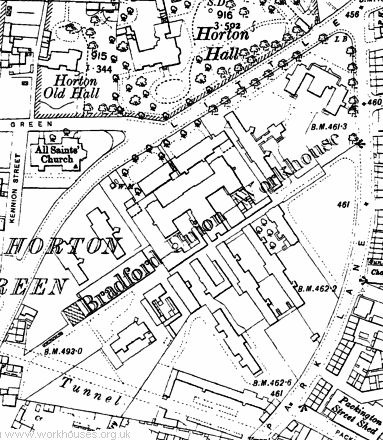
Bradford workhouse site, 1906.
White's 1854 Directory described the workhouse as "a spacious, handsome, and admirably arranged building, and stands upon 14 acres of land purchased at the cost of £4000. It has room for about 350 inmates, and attached to it is a spacious infirmary."
An entrance and administration block, mostly one storey high, lay alongside the road on Little Horton Lane. At the right of the central entrance archway were a committee room and the Guardians' board-room. To the left was a porter's lodge, out-relief office and waiting room. Above the entrance were probationary wards for new admissions to the workhouse, together with a clothes store and fumigation facility. At the outer ends of the entrance block were casual wards for the accommodation of passing tramps and vagrants, with the male ward at the left and female at the right.
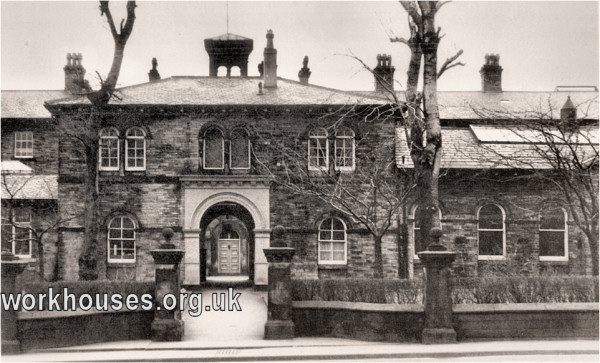
Bradford workhouse entrance block from the north-west, date unknown.
© Peter Higginbotham.
The main workhouse building was an elongated H-shaped block facing to the north-west. The Master and Matron's quarters were at the centre, with males housed to the left and females to the right. A central corridor ran the length of the building. The elderly and infirm were accommodated at the front of the building and the able-bodied at the rear. The end-wings at each side contained the boys' and girls' quarters at left and right respectively.
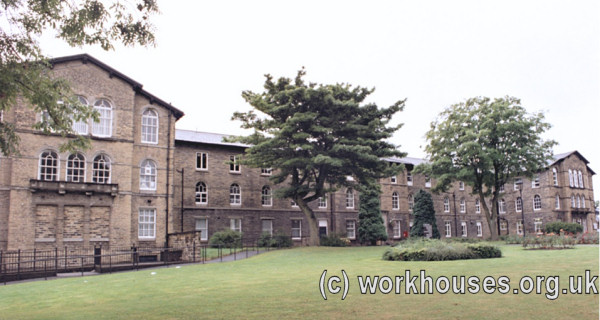
Bradford main block from the north, 2001.
© Peter Higginbotham.
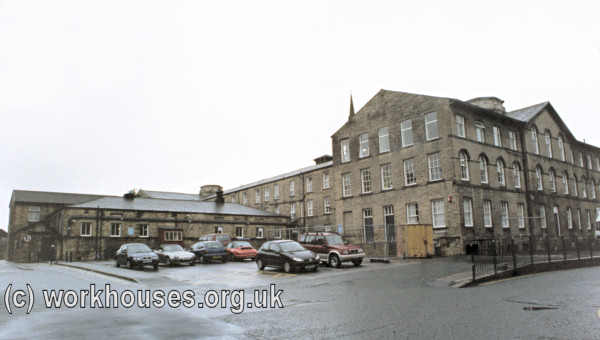
Bradford main block from east, 2001.
© Peter Higginbotham.
The new workhouse had problems with its staff — the master in 1851 was suspended for habitual drunkenness and immoral conduct. In 1852, other workhouse staff were accused of neglect after the death of an inmate. In the same year, the Guardians demanded the resignations of the master and matron for incompetence, and the workhouse tailor was dismissed for "an improper connection with a young female inmate".
In March 1866, workhouse campaigner Joseph Rowntree of Leeds submitted a report to the Bradford Observer complaining about the treatment of applicants to the workhouse casual ward, particularly those in need of medical attention. It was also alleged that no food was provided.
In the 1860s, four additional blocks were erected at the south of the workhouse, taking its capacity to 1,000.
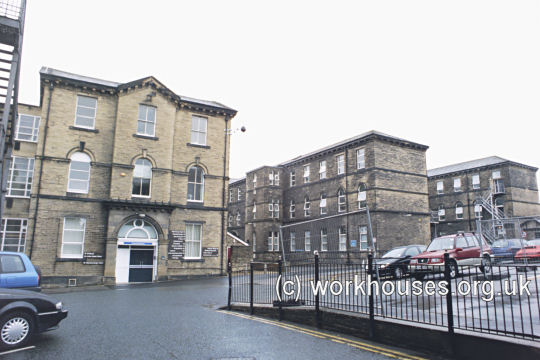
Bradford southern accommodation blocks from the north, 2001.
© Peter Higginbotham.
In 1904, a new T-shaped infirmary block was erected at the east of the main building.
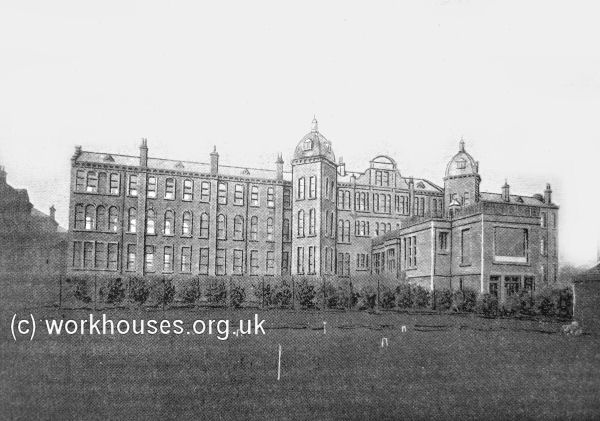
Bradford 1904 infirmary block from the east, c.1905.
© Peter Higginbotham.
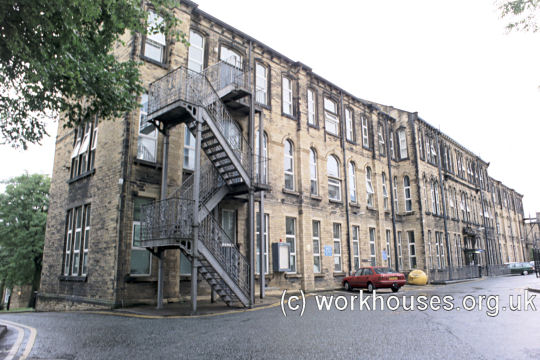
Bradford 1904 infirmary block from the north-west, 2001.
© Peter Higginbotham.
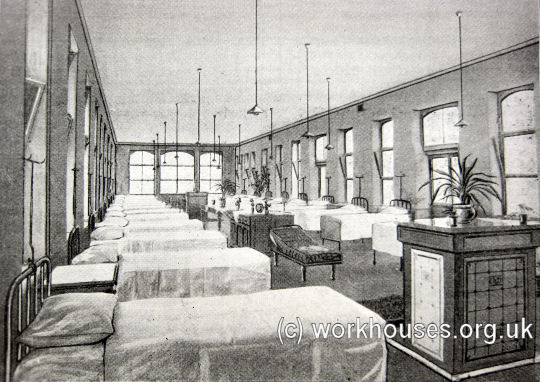
Bradford 1904 infirmary ward interior, c.1905.
© Peter Higginbotham.
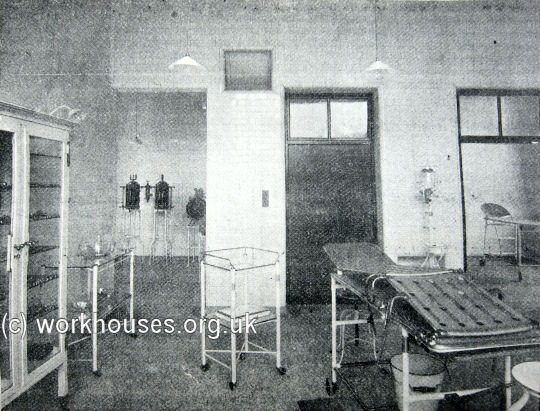
Bradford 1904 infirmary operating theatre, c.1905.
© Peter Higginbotham.
A collection of single-storey utility and workshop buildings were located at the west of the site.
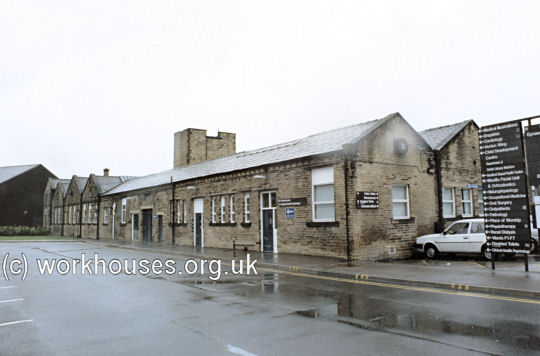
Bradford workshop blocks from the east, 2001.
© Peter Higginbotham.
The workhouse casual wards were originally at the outer ends of the front entrance block but were later moved to the south of the site with their entrance on Park Lane. In January 1904, a journalist made an undercover visit to the men's casual ward, an account of which appeared in the Brighouse News. A few weeks later, the same reporter was given a guided tour of the workhouse which he also recounted in an article for the same newspaper.
From 1904, to protect them from disadvantage in later life, the birth certificates for those born in the workhouse gave its address just as 217 Horton Lane, Little Horton.
During the First World War, the workhouse was used to accommodate military war casualties, with additional temporary wards being set up in huts erected in the grounds.
In 1920, there was a severe shortage of hospital accommodation in Bradford. The Bradford City Council's solution was to make use of the facilities at the workhouse which, at the end of the war, had 1,700 beds. The council negotiated a lease of the medical departments from the Bradford Guardians and on 1st April 1920, England's first municipal general hospital was inaugurated - initially for a five-year experimental period. St Luke's, as the hospital became known, received patients on the recommendation of a medical practitioner, with patients making a small payment based on their family income. The workhouse entrance and administration building was adapted for use as an out-patients department.
Homes for the Aged Poor
In 1907, the Bradford Guardians pioneered the provision of a separate "cottage homes" establishment for the elderly poor. The site chosen was at Daisy Hill, two miles to the north-west of Bradford.
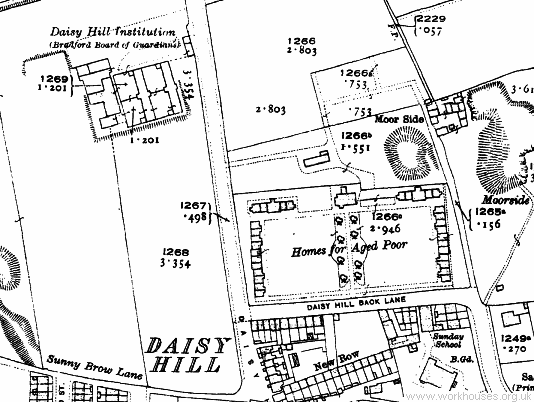
Bradford Daisy Hill cottage homes site, 1922.
The cottages were arranged around three sides of a rectangle. The central area, open to the south, contained grass and trees.
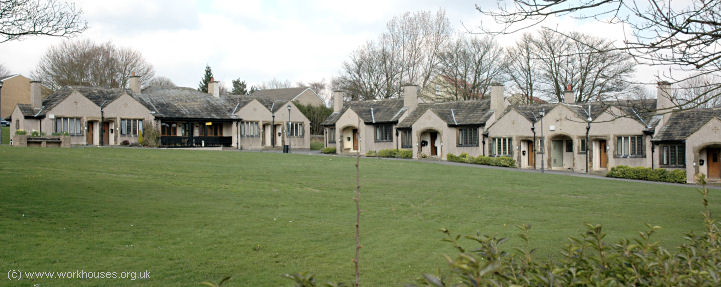
Bradford Daisy Hill cottages from the south-west, 2006.
© Peter Higginbotham.
A house at the centre of the northern side presumably contained the site superintendent's lodgings and offices.
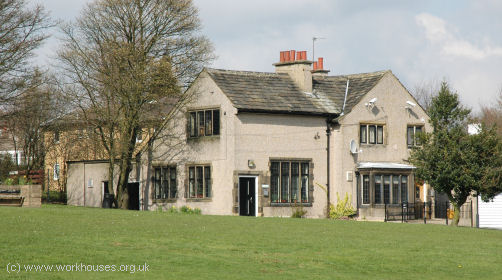
Bradford Daisy Hill cottages superintendent's house, 2006.
© Peter Higginbotham.
The cottages were later known as Hill Top Cottages. The site has latterly been used by local social services.
In 1912, the union's aged poor were also being accommodated at premises on Back Lane, Manningham.
Daisy Hill Workhouse
In 1913, after a decade since the scheme was first considered, the Bradford Guardians erected a second workhouse at Daisy Hill, not far from the Union's homes for the aged (see map above). It was designed by Fred Holland and originally used as a 'test' workhouse for the union's able-bodied paupers, while the Little Horton site was reserved for the sick and infirm.
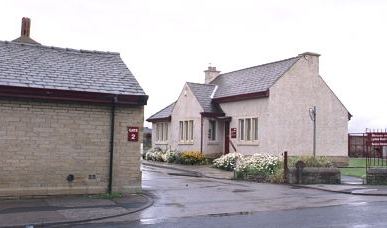
Daisy Hill workhouse entrance and lodge from the east, 2001.
© Peter Higginbotham.
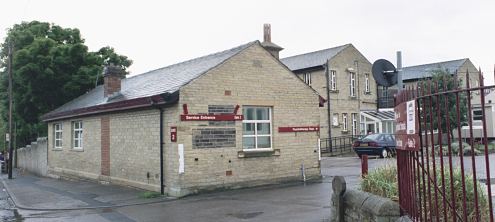
Daisy Hill workhouse receiving block from the north-east, 2001.
© Peter Higginbotham.
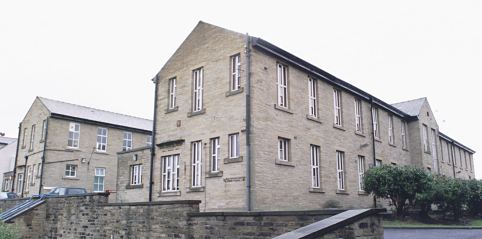
Daisy Hill workhouse main block from the south-east, 2001.
© Peter Higginbotham.
By 1917, Daisy Hill was being used to accommodate 'feeble-minded' male paupers.
The buildings, much enlarged, now house Lynfield Mount Hospital which provides psychiatric care facilities.
Children's Homes
By the early 1900s, the Bradford Union was operating a number of children's homes. The terminology used to describe the homes sources such as local directories is rather variable. There were "children's homes" at 40 Woodroyd Road and 7 West View, "cottage homes" at 151 Kensington Street, 86 Lister Avenue, 385 Killinghall Road, and 6 Lapage Street, and a "cottage home for boys" at 22 Ellercroft Terrace. In fact, all these establishments appear to be what are usually described as scattered homes.
The list of the homes' locations changed a little over the years, but at various times included: 25 Bishop Street, 20 Cumberland Road, 22 Ellercroft Terrace, 15 Farcliffe Place, 151 Kensington Street, 131 and 385 Killinghall Road, 4-6 Lapage street, 58 Leamington Street, 132 Lilycroft Road, 86 Lister Avenue, 80 Lower Rushton Road, 32 Marsh Street, 32 Marshfield Terrace, 57 Paley Road, 52 Rugby Place, 157 Salt Street, 13 and 168 St Leonard's Road, 15 St Margaret's Terrace, 7 West View, 196 Westwood Terrace, and 40 Woodroyd Road (all in Bradford), and Cavendish House, the Grove, Idle. There was also a Central and Receiving Home for new admissions to the homes at 85 to 93 Park Road, Bradford. By the early 1920s, a second Receivng Home had been opened at 9 Osborne Street.
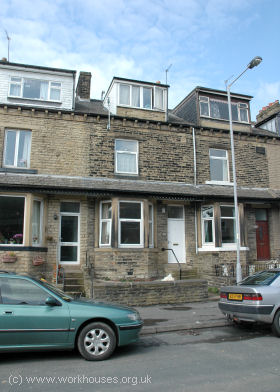
Bradford "cottage home" at 86 Lister Avenue, 2006.
© Peter Higginbotham.
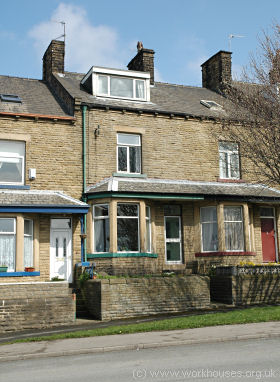
Bradford "cottage home" at 7 West View, 2006.
© Peter Higginbotham.
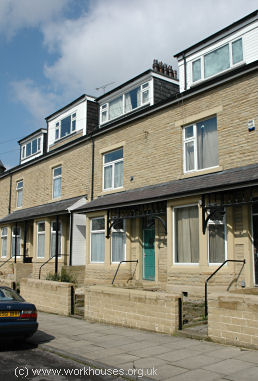
Bradford "children's home" at 40 Woodroyd Road, 2006.
© Peter Higginbotham.
Cavendish House, Idle
Eastby Sanatorium
In 1902-3, the Bradford Guardians erected a sanatorium near Eastby in north Yorkshire for the treatment of phthisis, or tuberculosis of the lungs. Eastby was possibly the first such establishment to be set up by a Poor Law Union. The Eastby site operated as branch of the Little Horton workhouse, with all patients having to be examined there first. The sanatorium's washing was also done at the workhouse laundry.
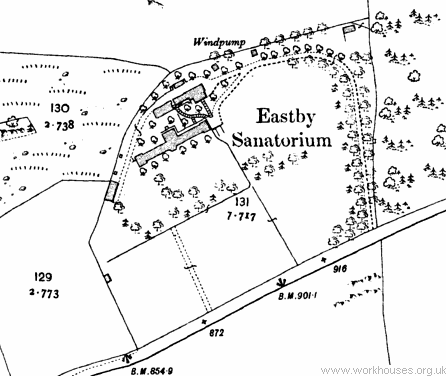
Bradford Eastby sanatorium site, 1909.
The eight-acre site occupied an elevated yet sheltered position with the wards facing to the south-east. The buildings, designed by Frederick Holland, comprised an administration block connected to an adjacent dining-room, a ward block, various outbuildings, and several shelters in the surrounding woods.

Eastby sanatorium administration block plan, c.1903.
The single-storey timber-built ward block could house 26 patients in rooms holding from one to five beds. Bathrooms lay at the centre-rear of the block, with a nurses' room above.
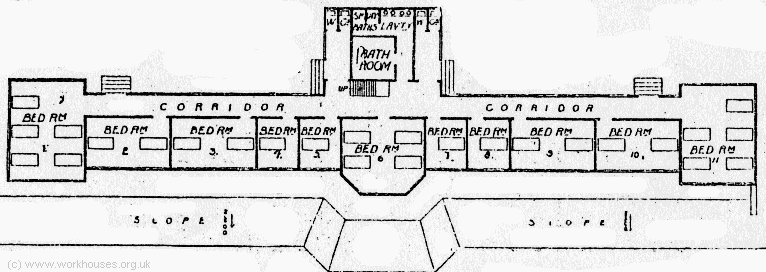
Eastby sanatorium ward block plan, c.1903.
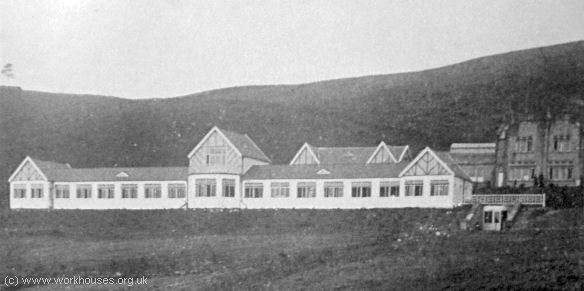
Bradford Eastby Sanatorium patients' block from the south-east, c.1905.
© Peter Higginbotham.
By the mid-1920s, the sanatorium had become Eastby Sanatorium and School, providing 83 beds for boys aged 4 to 16 suffering from tuberculosis.
The sanatorium closed during the 1940s, and most of the buildings demolished, Only the former administration block now survives, converted to use as a private house.
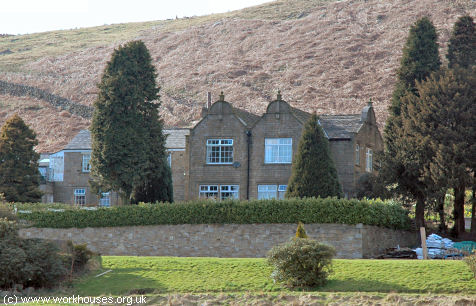
Bradford Eastby Sanatorium former administration block from the south-east, 2006.
© Peter Higginbotham.
Thackley Home
In around 1912, the union had plans to build a home for 'delicate' children at Thackley.
Bowling Park Institution
In 1913, the union had opened a 'colony' for 'feeble-minded' paupors at 283 Rooley Lane, at the south side of Bowling Park. Initially accommodating only men, accommodation was also provided for females in 1914.
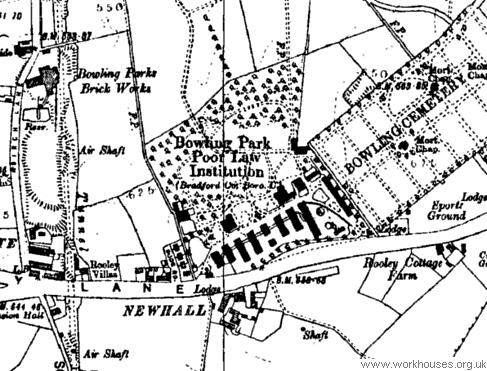
Bradford Bowling Park Institution, c.1938.
On March 5th, 1920, an inmate of Bowling park workhouse named Mary Brannan died at the age of 106. A native of Leeds, Mary had been in the care of the Bardford Guardians for 17 years, but had been transferred to Bowling Park just two weeks previously. SHe attributed he longevity to "a bit o' good baccy". She was an early riser and, even after reaching the age of 100, had often been seen in the workhouse grounds at 5 a.m. enjoying a smoke before breakfast.
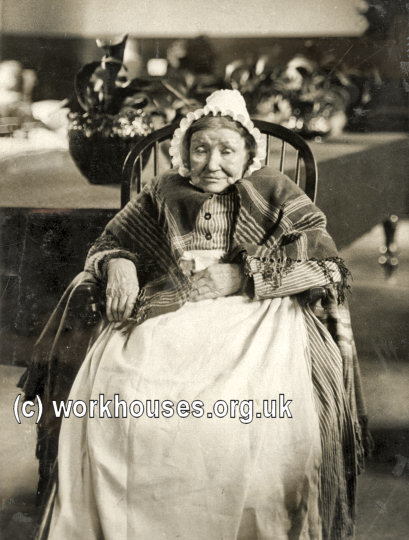
Mary Brannan in Bradford workhouse, aged 102.
© Peter Higginbotham.
The Bowling Park site later became known as the Park and closed in the 1970s.
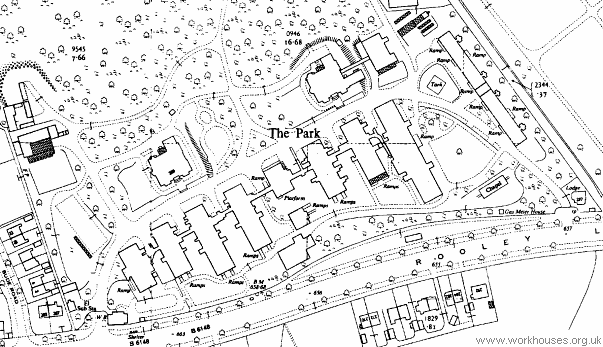
Bradford Bowling Park, c.1957.
Odsal Institution
In 1923, due to overcrowding at the Bowling Park institution, the union opened an establishment for feeble-minded females in the former sanatorium premises on Rooley Avenue. Later known as Northern View Hospital, the building no longer exists.
Staff
Inmates
Records
Note: many repositories impose a closure period of up to 100 years for records identifying individuals. Before travelling a long distance, always check that the records you want to consult will be available.
- West Yorkshire Archive Service (Bradford Office), Prince's Way, Bradford BD1 1NN. Holdings include: Various minutes (1837-1930); Admissions and discharges (1857-1930); Births and deaths (1838-1930); Creed registers (1869-1930); Punishment book (1888-1930); Register of adopted children (1899-1930); etc. Newly catalogued: Ref. 42D94/1/5; c1900-1902; Notes regarding the Bradford Poor Law Union: with details of the three Bradford wards which are represented by 21 guardians who themselves are divided up into four sections who sit every week to hear and receive applications for relief. There are seven committees: assessment, infirmary, children's, finance, visiting, vaccination and revision. There are also details of numbers of inmates in the Workhouse, numbers of children in the Central Home, and the Cottage Home. The cost of boarding out the boys and the efforts to reverse the "stigma of the Workhouse"; the rules of the workhouses; the cost per head; the positive arguments in the light of criticisms of the ratepayers; the routine for new arrivals at the Workhouse; food and diet of the inmates and the work they carry out, for example the cutting of granite.
Bibliography
- Ashforth, David (1979) The Poor Law in Bradford 1834-1871 (University of Bradford Ph. D. Thesis)
- Carter, P (Ed.) 2004 Bradford Poor Law Union — Papers and Correspondence with the Poor Law Commission, October 1834 to January 1839, Yorkshire Archaeological Society.
- Cudworth, W (1886) Ramble Round Horton
- Cudworth, W (1896) Manningham, Heaton and Allerton
- King, Steve (1997) Reconstructing Lives: The Poor, the Poor Law and Welfare in Calverley, 1650-1820 in Social History, vol.22, no.3, pp318-338.
- Rayner, Simeon (1887) The History and Antiquities of Pudsey
- Strong, Ruth (1982) Pudsey Workhouse (in Old West Riding, vol.2, no.2)
- White, W. (1847) Directory an318-338.d Topography of Leeds, Bradford, Halifax, Huddersfield, Wakefield, and the whole of the clothing districts of the West Riding of Yorkshire
- Wood, Malcolm (no date) Workhouse (unpublished typescript, Bradford Local Studies Library).
Links
- Rowntree's 1866 report.
- Ripon Workhouse Museum and Garden, Sharow View, Allhallowgate, Ripon HG4 1LE.
Acknowledgement
- Thanks to Pudsey Civic Society for use of Pudsey and Calverley archive images.
Unless otherwise indicated, this page () is copyright Peter Higginbotham. Contents may not be reproduced without permission.


